Na Zou
Rethinking the Understanding Ability across LLMs through Mutual Information
May 25, 2025Abstract:Recent advances in large language models (LLMs) have revolutionized natural language processing, yet evaluating their intrinsic linguistic understanding remains challenging. Moving beyond specialized evaluation tasks, we propose an information-theoretic framework grounded in mutual information (MI) to achieve this. We formalize the understanding as MI between an input sentence and its latent representation (sentence-level MI), measuring how effectively input information is preserved in latent representation. Given that LLMs learn embeddings for individual tokens, we decompose sentence-level MI into token-level MI between tokens and sentence embeddings, establishing theoretical bounds connecting these measures. Based on this foundation, we theoretically derive a computable lower bound for token-level MI using Fano's inequality, which directly relates to token-level recoverability-the ability to predict original tokens from sentence embedding. We implement this recoverability task to comparatively measure MI across different LLMs, revealing that encoder-only models consistently maintain higher information fidelity than their decoder-only counterparts, with the latter exhibiting a distinctive late-layer "forgetting" pattern where mutual information is first enhanced and then discarded. Moreover, fine-tuning to maximize token-level recoverability consistently improves understanding ability of LLMs on tasks without task-specific supervision, demonstrating that mutual information can serve as a foundation for understanding and improving language model capabilities.
MAIN-RAG: Multi-Agent Filtering Retrieval-Augmented Generation
Dec 31, 2024



Abstract:Large Language Models (LLMs) are becoming essential tools for various natural language processing tasks but often suffer from generating outdated or incorrect information. Retrieval-Augmented Generation (RAG) addresses this issue by incorporating external, real-time information retrieval to ground LLM responses. However, the existing RAG systems frequently struggle with the quality of retrieval documents, as irrelevant or noisy documents degrade performance, increase computational overhead, and undermine response reliability. To tackle this problem, we propose Multi-Agent Filtering Retrieval-Augmented Generation (MAIN-RAG), a training-free RAG framework that leverages multiple LLM agents to collaboratively filter and score retrieved documents. Specifically, MAIN-RAG introduces an adaptive filtering mechanism that dynamically adjusts the relevance filtering threshold based on score distributions, effectively minimizing noise while maintaining high recall of relevant documents. The proposed approach leverages inter-agent consensus to ensure robust document selection without requiring additional training data or fine-tuning. Experimental results across four QA benchmarks demonstrate that MAIN-RAG consistently outperforms traditional RAG approaches, achieving a 2-11% improvement in answer accuracy while reducing the number of irrelevant retrieved documents. Quantitative analysis further reveals that our approach achieves superior response consistency and answer accuracy over baseline methods, offering a competitive and practical alternative to training-based solutions.
Gradient Rewiring for Editable Graph Neural Network Training
Oct 21, 2024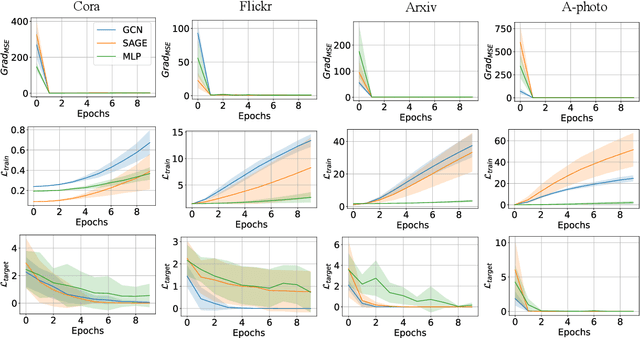
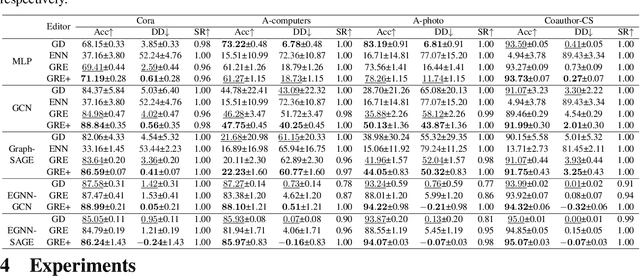

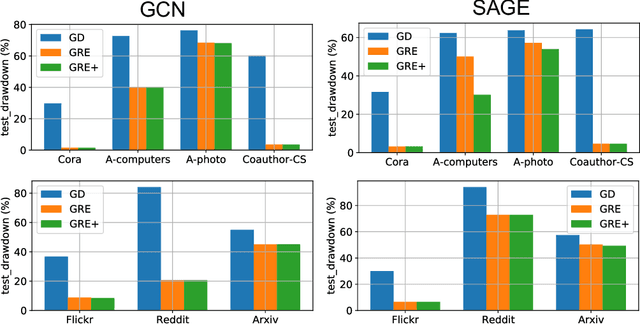
Abstract:Deep neural networks are ubiquitously adopted in many applications, such as computer vision, natural language processing, and graph analytics. However, well-trained neural networks can make prediction errors after deployment as the world changes. \textit{Model editing} involves updating the base model to correct prediction errors with less accessible training data and computational resources. Despite recent advances in model editors in computer vision and natural language processing, editable training in graph neural networks (GNNs) is rarely explored. The challenge with editable GNN training lies in the inherent information aggregation across neighbors, which can lead model editors to affect the predictions of other nodes unintentionally. In this paper, we first observe the gradient of cross-entropy loss for the target node and training nodes with significant inconsistency, which indicates that directly fine-tuning the base model using the loss on the target node deteriorates the performance on training nodes. Motivated by the gradient inconsistency observation, we propose a simple yet effective \underline{G}radient \underline{R}ewiring method for \underline{E}ditable graph neural network training, named \textbf{GRE}. Specifically, we first store the anchor gradient of the loss on training nodes to preserve the locality. Subsequently, we rewire the gradient of the loss on the target node to preserve performance on the training node using anchor gradient. Experiments demonstrate the effectiveness of GRE on various model architectures and graph datasets in terms of multiple editing situations. The source code is available at \url{https://github.com/zhimengj0326/Gradient_rewiring_editing}
IDEA: A Flexible Framework of Certified Unlearning for Graph Neural Networks
Jul 28, 2024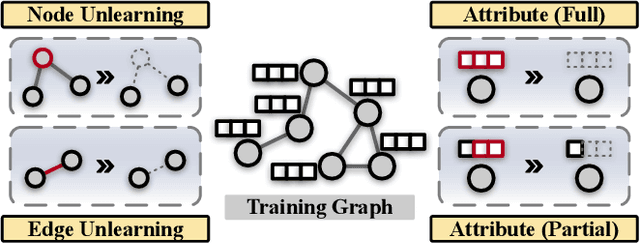
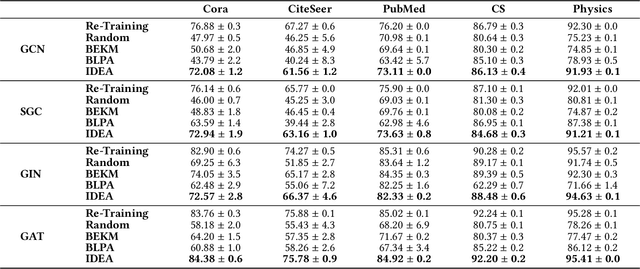
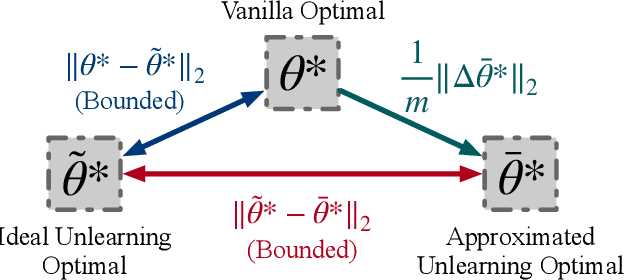

Abstract:Graph Neural Networks (GNNs) have been increasingly deployed in a plethora of applications. However, the graph data used for training may contain sensitive personal information of the involved individuals. Once trained, GNNs typically encode such information in their learnable parameters. As a consequence, privacy leakage may happen when the trained GNNs are deployed and exposed to potential attackers. Facing such a threat, machine unlearning for GNNs has become an emerging technique that aims to remove certain personal information from a trained GNN. Among these techniques, certified unlearning stands out, as it provides a solid theoretical guarantee of the information removal effectiveness. Nevertheless, most of the existing certified unlearning methods for GNNs are only designed to handle node and edge unlearning requests. Meanwhile, these approaches are usually tailored for either a specific design of GNN or a specially designed training objective. These disadvantages significantly jeopardize their flexibility. In this paper, we propose a principled framework named IDEA to achieve flexible and certified unlearning for GNNs. Specifically, we first instantiate four types of unlearning requests on graphs, and then we propose an approximation approach to flexibly handle these unlearning requests over diverse GNNs. We further provide theoretical guarantee of the effectiveness for the proposed approach as a certification. Different from existing alternatives, IDEA is not designed for any specific GNNs or optimization objectives to perform certified unlearning, and thus can be easily generalized. Extensive experiments on real-world datasets demonstrate the superiority of IDEA in multiple key perspectives.
Chasing Fairness in Graphs: A GNN Architecture Perspective
Dec 19, 2023



Abstract:There has been significant progress in improving the performance of graph neural networks (GNNs) through enhancements in graph data, model architecture design, and training strategies. For fairness in graphs, recent studies achieve fair representations and predictions through either graph data pre-processing (e.g., node feature masking, and topology rewiring) or fair training strategies (e.g., regularization, adversarial debiasing, and fair contrastive learning). How to achieve fairness in graphs from the model architecture perspective is less explored. More importantly, GNNs exhibit worse fairness performance compared to multilayer perception since their model architecture (i.e., neighbor aggregation) amplifies biases. To this end, we aim to achieve fairness via a new GNN architecture. We propose \textsf{F}air \textsf{M}essage \textsf{P}assing (FMP) designed within a unified optimization framework for GNNs. Notably, FMP \textit{explicitly} renders sensitive attribute usage in \textit{forward propagation} for node classification task using cross-entropy loss without data pre-processing. In FMP, the aggregation is first adopted to utilize neighbors' information and then the bias mitigation step explicitly pushes demographic group node presentation centers together. In this way, FMP scheme can aggregate useful information from neighbors and mitigate bias to achieve better fairness and prediction tradeoff performance. Experiments on node classification tasks demonstrate that the proposed FMP outperforms several baselines in terms of fairness and accuracy on three real-world datasets. The code is available in {\url{https://github.com/zhimengj0326/FMP}}.
Marginal Nodes Matter: Towards Structure Fairness in Graphs
Oct 23, 2023

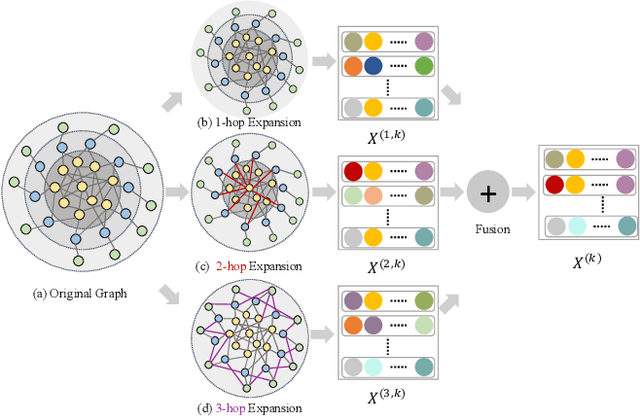
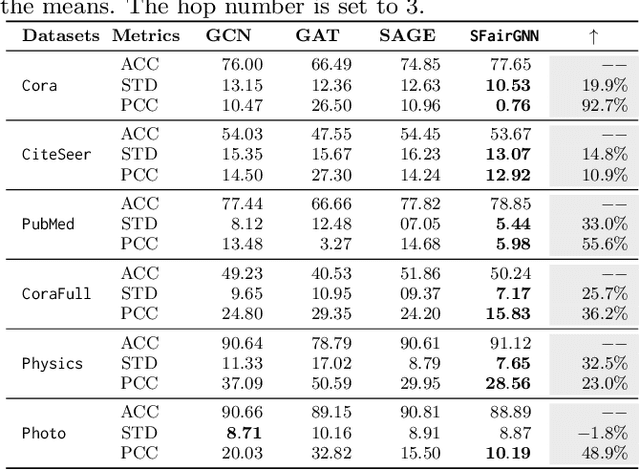
Abstract:In social network, a person located at the periphery region (marginal node) is likely to be treated unfairly when compared with the persons at the center. While existing fairness works on graphs mainly focus on protecting sensitive attributes (e.g., age and gender), the fairness incurred by the graph structure should also be given attention. On the other hand, the information aggregation mechanism of graph neural networks amplifies such structure unfairness, as marginal nodes are often far away from other nodes. In this paper, we focus on novel fairness incurred by the graph structure on graph neural networks, named \emph{structure fairness}. Specifically, we first analyzed multiple graphs and observed that marginal nodes in graphs have a worse performance of downstream tasks than others in graph neural networks. Motivated by the observation, we propose \textbf{S}tructural \textbf{Fair} \textbf{G}raph \textbf{N}eural \textbf{N}etwork (SFairGNN), which combines neighborhood expansion based structure debiasing with hop-aware attentive information aggregation to achieve structure fairness. Our experiments show \SFairGNN can significantly improve structure fairness while maintaining overall performance in the downstream tasks.
CODA: Temporal Domain Generalization via Concept Drift Simulator
Oct 02, 2023Abstract:In real-world applications, machine learning models often become obsolete due to shifts in the joint distribution arising from underlying temporal trends, a phenomenon known as the "concept drift". Existing works propose model-specific strategies to achieve temporal generalization in the near-future domain. However, the diverse characteristics of real-world datasets necessitate customized prediction model architectures. To this end, there is an urgent demand for a model-agnostic temporal domain generalization approach that maintains generality across diverse data modalities and architectures. In this work, we aim to address the concept drift problem from a data-centric perspective to bypass considering the interaction between data and model. Developing such a framework presents non-trivial challenges: (i) existing generative models struggle to generate out-of-distribution future data, and (ii) precisely capturing the temporal trends of joint distribution along chronological source domains is computationally infeasible. To tackle the challenges, we propose the COncept Drift simulAtor (CODA) framework incorporating a predicted feature correlation matrix to simulate future data for model training. Specifically, CODA leverages feature correlations to represent data characteristics at specific time points, thereby circumventing the daunting computational costs. Experimental results demonstrate that using CODA-generated data as training input effectively achieves temporal domain generalization across different model architectures.
Beyond Fairness: Age-Harmless Parkinson's Detection via Voice
Sep 23, 2023
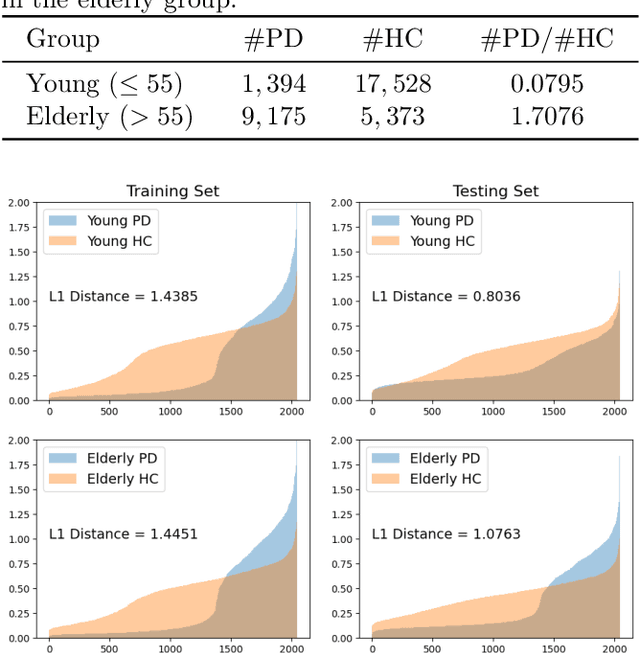
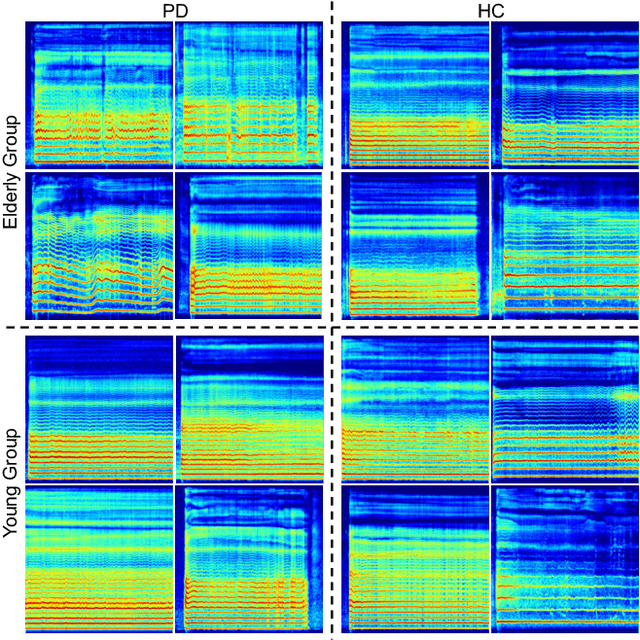
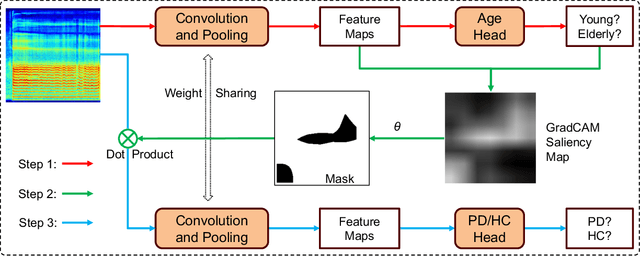
Abstract:Parkinson's disease (PD), a neurodegenerative disorder, often manifests as speech and voice dysfunction. While utilizing voice data for PD detection has great potential in clinical applications, the widely used deep learning models currently have fairness issues regarding different ages of onset. These deep models perform well for the elderly group (age $>$ 55) but are less accurate for the young group (age $\leq$ 55). Through our investigation, the discrepancy between the elderly and the young arises due to 1) an imbalanced dataset and 2) the milder symptoms often seen in early-onset patients. However, traditional debiasing methods are impractical as they typically impair the prediction accuracy for the majority group while minimizing the discrepancy. To address this issue, we present a new debiasing method using GradCAM-based feature masking combined with ensemble models, ensuring that neither fairness nor accuracy is compromised. Specifically, the GradCAM-based feature masking selectively obscures age-related features in the input voice data while preserving essential information for PD detection. The ensemble models further improve the prediction accuracy for the minority (young group). Our approach effectively improves detection accuracy for early-onset patients without sacrificing performance for the elderly group. Additionally, we propose a two-step detection strategy for the young group, offering a practical risk assessment for potential early-onset PD patients.
DISPEL: Domain Generalization via Domain-Specific Liberating
Aug 01, 2023



Abstract:Domain generalization aims to learn a generalization model that can perform well on unseen test domains by only training on limited source domains. However, existing domain generalization approaches often bring in prediction-irrelevant noise or require the collection of domain labels. To address these challenges, we consider the domain generalization problem from a different perspective by categorizing underlying feature groups into domain-shared and domain-specific features. Nevertheless, the domain-specific features are difficult to be identified and distinguished from the input data. In this work, we propose DomaIn-SPEcific Liberating (DISPEL), a post-processing fine-grained masking approach that can filter out undefined and indistinguishable domain-specific features in the embedding space. Specifically, DISPEL utilizes a mask generator that produces a unique mask for each input data to filter domain-specific features. The DISPEL framework is highly flexible to be applied to any fine-tuned models. We derive a generalization error bound to guarantee the generalization performance by optimizing a designed objective loss. The experimental results on five benchmarks demonstrate DISPEL outperforms existing methods and can further generalize various algorithms.
Towards Assumption-free Bias Mitigation
Jul 09, 2023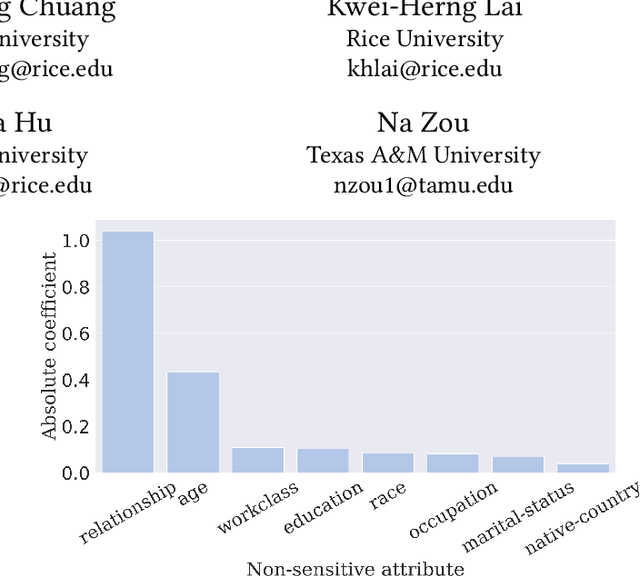



Abstract:Despite the impressive prediction ability, machine learning models show discrimination towards certain demographics and suffer from unfair prediction behaviors. To alleviate the discrimination, extensive studies focus on eliminating the unequal distribution of sensitive attributes via multiple approaches. However, due to privacy concerns, sensitive attributes are often either unavailable or missing in real-world scenarios. Therefore, several existing works alleviate the bias without sensitive attributes. Those studies face challenges, either in inaccurate predictions of sensitive attributes or the need to mitigate unequal distribution of manually defined non-sensitive attributes related to bias. The latter requires strong assumptions about the correlation between sensitive and non-sensitive attributes. As data distribution and task goals vary, the strong assumption on non-sensitive attributes may not be valid and require domain expertise. In this work, we propose an assumption-free framework to detect the related attributes automatically by modeling feature interaction for bias mitigation. The proposed framework aims to mitigate the unfair impact of identified biased feature interactions. Experimental results on four real-world datasets demonstrate that our proposed framework can significantly alleviate unfair prediction behaviors by considering biased feature interactions.
 Add to Chrome
Add to Chrome Add to Firefox
Add to Firefox Add to Edge
Add to Edge